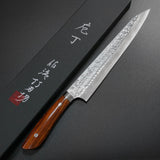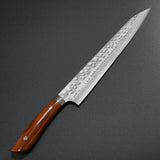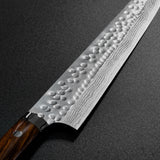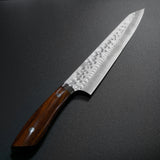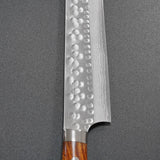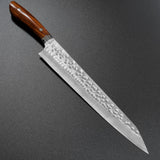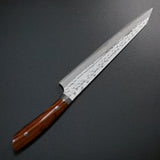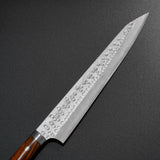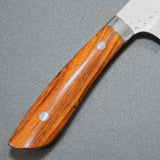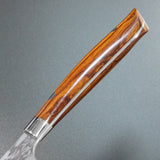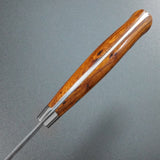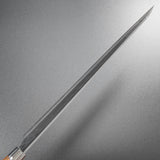Saji Takeshi SRS13 Hammered Damascus Sujihiki 270mm Ironwood
Type: Sujihiki (Double bevel edged)
Blade Material: SRS13 (Powder High Speed Steel) Clad Stainless Steel
Core: SRS13
Blade Length: approx 270 mm
Blade Width: approx 42 mm
Thickness of Spine: approx max 2 mm
Overall Length: approx 398 mm
Weight: approx 222 g (7.8 oz)
Handle: Ironwood
HRC: 63
Made in Japan
The knives made in Echizen city are called Echizen Uchi Hamono. The art of making Japanese kitchen knives has a history of about 700 years. Echizen Uchi Hamono is designated as "Traditional Crafts" by the Minister for Economy, Trade and Industry.
Takeshi Saji is a traditional craftsman who is the third generation in Saji Uchi hamono Co., Ltd. He makes custom knives and even billhooks, and his name is well known to collectors all over the world. His Japanese style field knives are used by field workers and outdoor professionals all over the world. He continues to make innovative and original knives.
In 2020, Kazuo Nomura, the representative of Saji Uchihamono Co., Ltd., was certified as a traditional craftsman, and he continues to create new designs of Knives with Saji Takeshi.
The elegant wave pattern called the popular name "Sumi Nagashi" is one of the treasure which Japanese cutlery culture produced. Like the Japanese sword "Katana", the blade is made with low and high carbon stainless steel to layers. The same wave pattern does not exist. Beautiful damascus pattern is made by a belt hammer. This knife is more than just a kitchen knife, is a work of art.
About "SRS13"
SRS13 is Powder high speed steel. This is stainless steel that boasts extremely high hardness and wear resistance. It contains about 1.50% carbon like Aogami Super Steel and contains molybdenum and vanadium in a high ratio to prevent rusting and has sharpness. And the edge retention is outstanding due to its high hardness.
About Japanese Knives
Japanese knives are made by craftsmen and machines, there might be scratch. Most Japanese knives are thin blade. Don't twist edge, and don't cut and hit frozen foods or bones, the edge will be chipped or broken.














